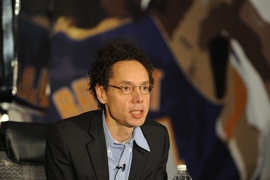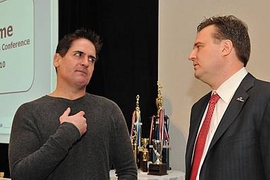After Daryl Morey SM ’00 took over as general manager of the NBA’s Houston Rockets in 2006, he asked his analytics staff to study the success rate of the plays that then-coach Jeff Van Gundy was calling from the sidelines. While Van Gundy’s play-calling was very good, the analysis turned up one unanticipated result.
“Our best play was ‘random,’” Morey said — that is, when an offensive set or play would break down, the call “random” would signal that Rockets players should use ad-hoc moves to free the ball-handler. Time and again, the improvised offense befuddled well-prepped defenses, Morey explained during a panel at the eighth annual MIT Sloan Sports Analytics Conference (SSAC), held this weekend in Boston.
“Chaos is very useful,” said fellow panelist Bill James, whose work on baseball in the 1980s helped set the foundations of modern analytics.
James’ observation might also apply to the field of sports analytics itself, which has grown in large part through the work of outsiders. The power of many minds, using easily available statistics, has produced waves of breakthroughs in recent decades.
“The guys like me who do this for free are ahead of the actual teams,” Brian Burke, a freelance analyst, said during the conference’s “Football Analytics” panel. Burke has provided one of several compelling outsider analyses showing that NFL coaches are consistently too cautious in fourth-down situations.
Can such outsider-based advances continue at a time when things like optical tracking systems — whose use has expanded rapidly in stadiums and arenas during the last two years — make sports analytics a more costly, proprietary enterprise? The fact that Burke was criticizing NFL teams while seated on a panel with NFL executives suggests a symbiosis at work: Outsiders produce innovations, and either become insiders or gain influence. Since its inception in 2007, SSAC has helped create this symbiosis.
The conference always features high-profile panelists — this year, famed basketball coach Phil Jackson made his MIT debut, while NBA Commissioner Adam Silver and writer Malcolm Gladwell aired some sharp-edged disagreements — along with a research paper competition, trade show, and ample networking opportunities for nearly 3,000 attendees, including officials from dozens of professional teams.
Candor on stage: Tanking, doping, and ‘greed’ charges
This year’s event had public discussions as lively as any the conference has seen. Much buzz followed the one-on-one discussion between Silver and Gladwell, where Gladwell assertively chided Silver for the public funding that professional basketball franchises — he used the New York Knicks as an example — receive from local governments.
“There is a point here where owners are clearly being greedy,” Gladwell said, noting that 31 percent of children in New York City are living under the poverty line.
However, Silver countered, “It’s an enormous net plus having the Knicks and Nets in New York City,” referring to the additional economic activity sports franchises may produce.
Further NBA news was made by Bryan Colangelo, the former general manager of the Toronto Raptors, who admitted that he “tried to tank,” or lose games intentionally to get a better draft pick, while running the team. Meanwhile, at a panel on doping, former star cyclist Tyler Hamilton spoke emotionally about the “double life” he lived as a doping athlete, and contended that the sport’s code of silence about cheating “still exists.”
Who controls the data?
Indeed, to sense the reach of sports analytics, consider that even in cycling, analytics-minded outsiders have had an unexpected impact, refining certain metrics — such as the ratio of power generation to body weight — in an effort to determine which riders are likeliest to be doping.
Such metrics “are really important,” said Travis Tygart, head of the U.S. Anti-Doping Agency, which published the 2012 report concluding that Lance Armstrong had doped while winning his Tour de France titles. To be sure, Tygart emphasized, these numbers fall short of proof; they suggest anomalous results for further scrutiny. Still, he added, solid analytics should be “part of the overall anti-doping package” used in the sport.
“There were times I should have been targeted first,” Hamilton added.
But how might reliable performance data become more widely available? Talking to MIT News after the panel, Tygart suggested that part of the World Anti-Doping Agency code could possibly be amended to require greater disclosure from cycling teams, although such a move is not currently in the offing.
Doping aside, making more data publicly available could help professional leagues sustain their popularity and generate new knowledge, some conference attendees said. Take Arturo Galletti and Andres Alvarez — basketball analytics bloggers whose day jobs involve operations management and web development, respectively — who now write for a site called “Box Score Geeks.” They advocate a metric to evaluate players called “wins produced,” which emphasizes efficient shooting; Dallas Mavericks owner Mark Cuban is among those familiar with the statistic, which comes from published box scores.
For Galletti and Alvarez, too much proprietary data means fewer insightful people in sports analytics. “My concern is that we’re at the end of a golden age,” Galletti said, noting: “There’s real value to having the crowdsourcing model. You have this large community that’s passionate about sports. It’s important for leagues to tap into this energy. [SSAC] shows there’s demand for this.”
And as Alvarez noted about proprietary findings, “I can’t replicate the results.” If too much sports data is walled off, Galletti added, teams “will make worse-informed decisions.”
And the winner is …
Still, research is proceeding; one paper in the conference’s competition even used optical data to assess offensive and defensive tactics in ultimate Frisbee. The winning paper, “The Three Dimensions of Rebounding,” used optical data to take a granular look at rebounding in basketball. Two papers by MIT faculty and students were among the finalists.
That kind of analysis will find a home among NBA teams. However, “There’s no substitute for watching film over and over and over again,” said Stan Van Gundy, former coach of the NBA’s Miami Heat and Orlando Magic, representing a consensus view: Useful analytics can only stem from substantive knowledge of a sport.
And for a cadre of well-informed teams, both honed intuition and numbers-crunching are considered essential.
“You have to have analysts,” John Henry, principal owner of the Fenway Sports Group, which runs Boston Red Sox, said. “They don’t necessarily dictate everything you do, but they’re going to inform everything you do, or you’re not doing your work.”
Sloan Sports Analytics Conference underscores teams’ interest in statistics.
Publication Date:
Press Contact:
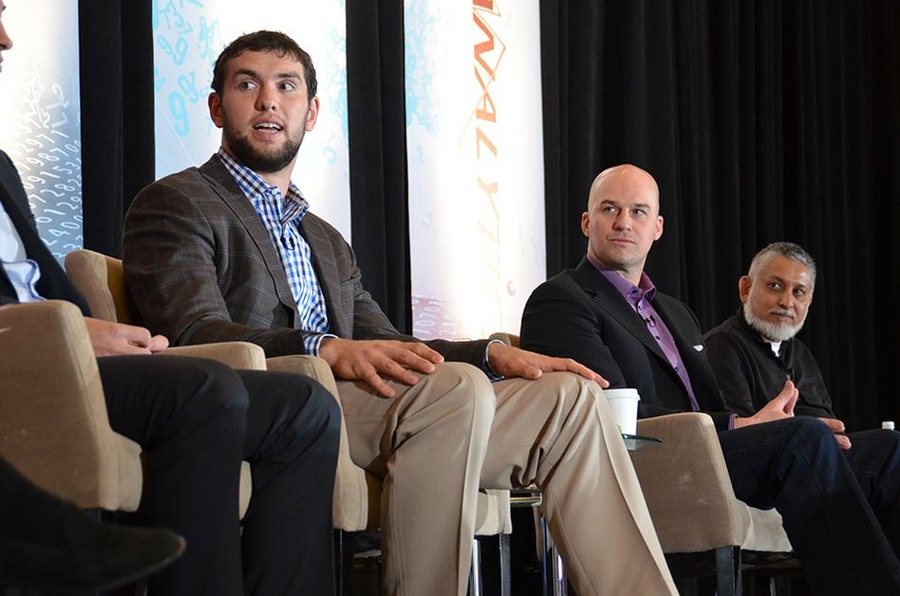
Caption:
Indianpolis Colts quarterback Andrew Luck (left) during a panel discussion on "Athlete Analytics" at the 2014 MIT Sloan Sports Analytics Conference, held Feb. 28-March 1 in Boston.
Credits:
<br />Photo: Ellen Glassman

Caption:
Politics and sports analysts Nate Silver (left) and baseball analyst Bill James discuss sports innovations.
Credits:
<br />Photo: Ellen Glassman
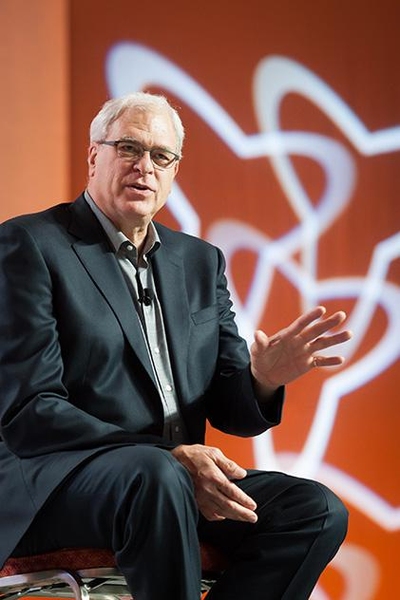
Caption:
Former Chicago Bulls and Los Angeles Lakers head coach Phil Jackson discusses sports dynasties.
Credits:
<br />Photo: Andrew Kubica
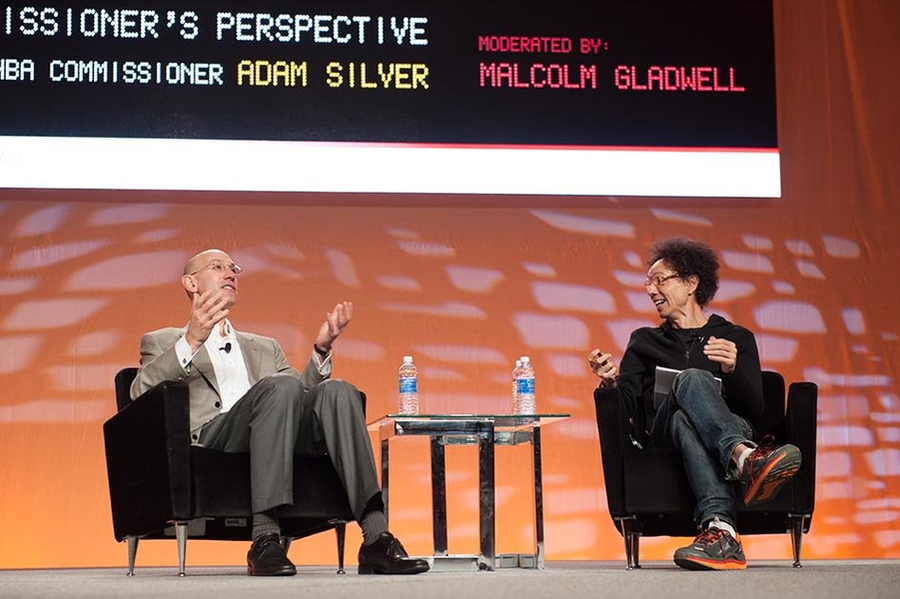
Caption:
NBA commissioner Adam Silver (left) and author Malcolm Gladwell discuss the state of professional basketball.
Credits:
<br />Photo: Andrew Kubica
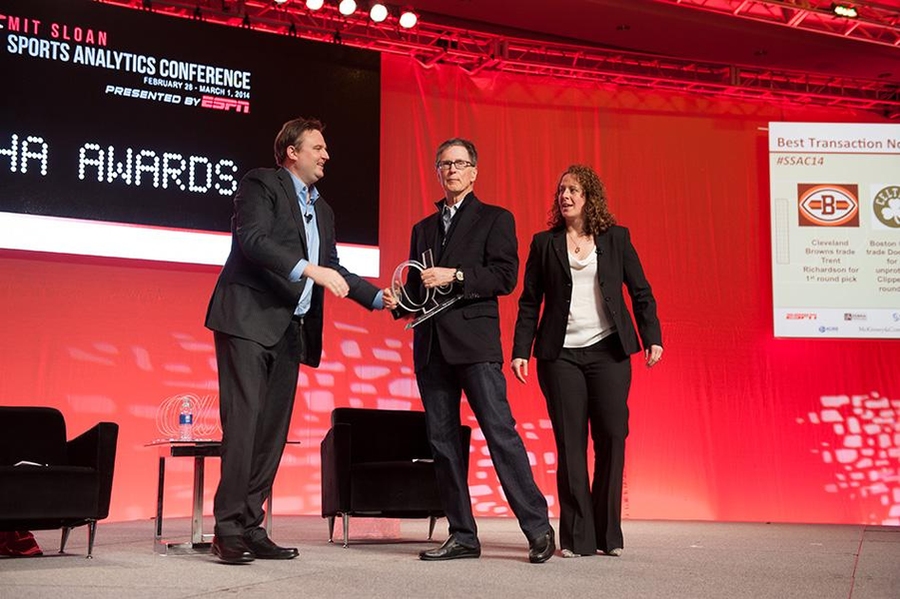
Caption:
Daryl Morey SM '00 (left), Houston Rockets general manager and conference co-chair; John Henry (center), principal owner of the Fenway Sports Group, which runs the Boston Red Sox and Liverpool F.C.; and Jessica Gelman, a vice president of the Kraft Sports Group, which runs the New England Patriots and New England Revolution, also a conference co-chair, at the awards ceremony concluding the 2014 MIT Sloan Sports Analytics Conference.
Credits:
<br />Photo: Andrew Kubica

Caption:
Daryl Morey
Credits:
Photo courtesy of MIT Alumni Association

Related Topics
Related Articles




